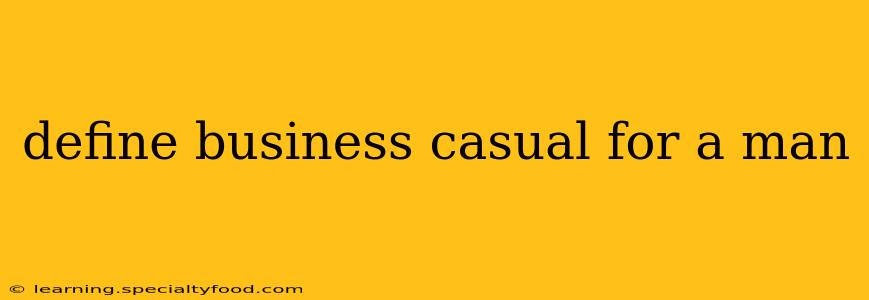Business casual is a tricky dress code. It's more relaxed than traditional business attire, but it's still professional enough for the workplace. Finding the right balance can be challenging, so let's break down what constitutes business casual for men and help you navigate this style successfully.
This guide offers more than just a list of clothing items; it delves into the nuances of fabric, fit, and overall presentation to ensure you project confidence and professionalism in any business casual setting.
What is Business Casual for Men?
Business casual generally signifies a step down from a suit and tie, aiming for a polished yet comfortable appearance. It blends professionalism with a touch of relaxed style. The key is to look presentable and appropriate for the workplace without appearing overdressed or underdressed. The specific interpretation can vary slightly depending on the company culture and industry, so paying attention to your workplace's norms is crucial.
What to Wear: Key Components of a Business Casual Outfit
Here's a breakdown of acceptable clothing options for a business casual look:
Tops:
- Dress Shirts (Button-Downs): These are a staple. Opt for solid colors (blues, grays, whites) or subtle patterns (small checks, stripes). Avoid anything too flashy or loud.
- Polos: High-quality polos in neutral colors are suitable, especially in more relaxed business casual environments. Ensure they are wrinkle-free and well-fitting.
- Knit Sweaters: A cardigan or v-neck sweater can add sophistication, especially layered over a dress shirt or polo. Choose neutral colors or subtle patterns.
Bottoms:
- Dress Pants: These are the most traditional choice. Choose well-fitting pants in neutral colors like navy, gray, or khaki. Avoid overly distressed or faded denim.
- Chinos: Chinos are a versatile option, offering a more relaxed feel than dress pants. Opt for darker colors and avoid excessively casual styles.
- Dark-Wash Jeans (with caution): In some less formal business casual settings, dark-wash jeans can be acceptable, but always err on the side of caution. Ensure they are well-fitting and free of rips, tears, or distressing.
Shoes:
- Leather Loafers: These are a classic and sophisticated choice for business casual.
- Oxfords: Similar to loafers, oxfords offer a polished look.
- Clean Sneakers (with caution): In some modern and relaxed business casual settings, clean, well-maintained sneakers (avoid running shoes) may be acceptable. However, always check your workplace's dress code first.
Accessories:
- Belt: A leather belt in a matching or complementary color to your shoes is a smart touch.
- Watch: A classic watch adds a touch of sophistication.
- Tie (optional): A tie might be appropriate in some business casual settings, particularly if you're meeting with clients or attending important meetings.
What to Avoid in Business Casual Attire
- Graphic Tees: Avoid any shirts with logos or graphics.
- Shorts: Shorts are generally not considered business casual appropriate, unless specifically permitted by your workplace.
- Flip-Flops or Sandals: These are never appropriate for business casual.
- Overly Casual Jeans: Ripped, faded, or distressed jeans are a definite no-go.
- Loud Patterns or Colors: Keep your clothing choices relatively muted and professional.
How to Choose the Right Business Casual Outfit for the Occasion
The key to mastering business casual is understanding context. A client meeting may call for a more formal approach (dress shirt, dress pants, loafers), while a Friday afternoon in the office might allow for a slightly more relaxed look (polo, chinos, clean sneakers—if appropriate). Observe your colleagues and superiors to gauge the accepted level of formality.
H2: What is considered inappropriate for business casual attire?
Anything too casual or revealing is generally inappropriate. This includes clothing with offensive slogans, excessively revealing necklines or hemlines, and clothing that is stained, ripped, or otherwise damaged.
H2: What is the difference between business casual and smart casual?
While the lines can be blurry, business casual generally maintains a higher level of professionalism than smart casual. Business casual tends to favor dress pants or chinos over jeans and often includes a button-down shirt or polo. Smart casual might permit slightly more casual elements, like dark wash jeans or a less formal shirt. The context of the event or workplace will dictate which is most appropriate.
H2: Can I wear a suit to a business casual event?
While not strictly wrong, wearing a suit to a business casual event might make you seem overdressed. It's usually best to opt for a more relaxed but still professional outfit unless the event specifically requests or implies formal attire.
H2: How important is fit when it comes to business casual?
Fit is paramount. Well-fitting clothes project professionalism and confidence. Ill-fitting clothes, regardless of their quality or price, can detract from your overall appearance. Ensure your shirts fit comfortably without being baggy or too tight and that your pants fit well without being too loose or too constricting.
By following these guidelines, you'll be well-equipped to navigate the often ambiguous world of men's business casual attire. Remember, confidence is key, and presenting yourself well will always leave a positive impression.
